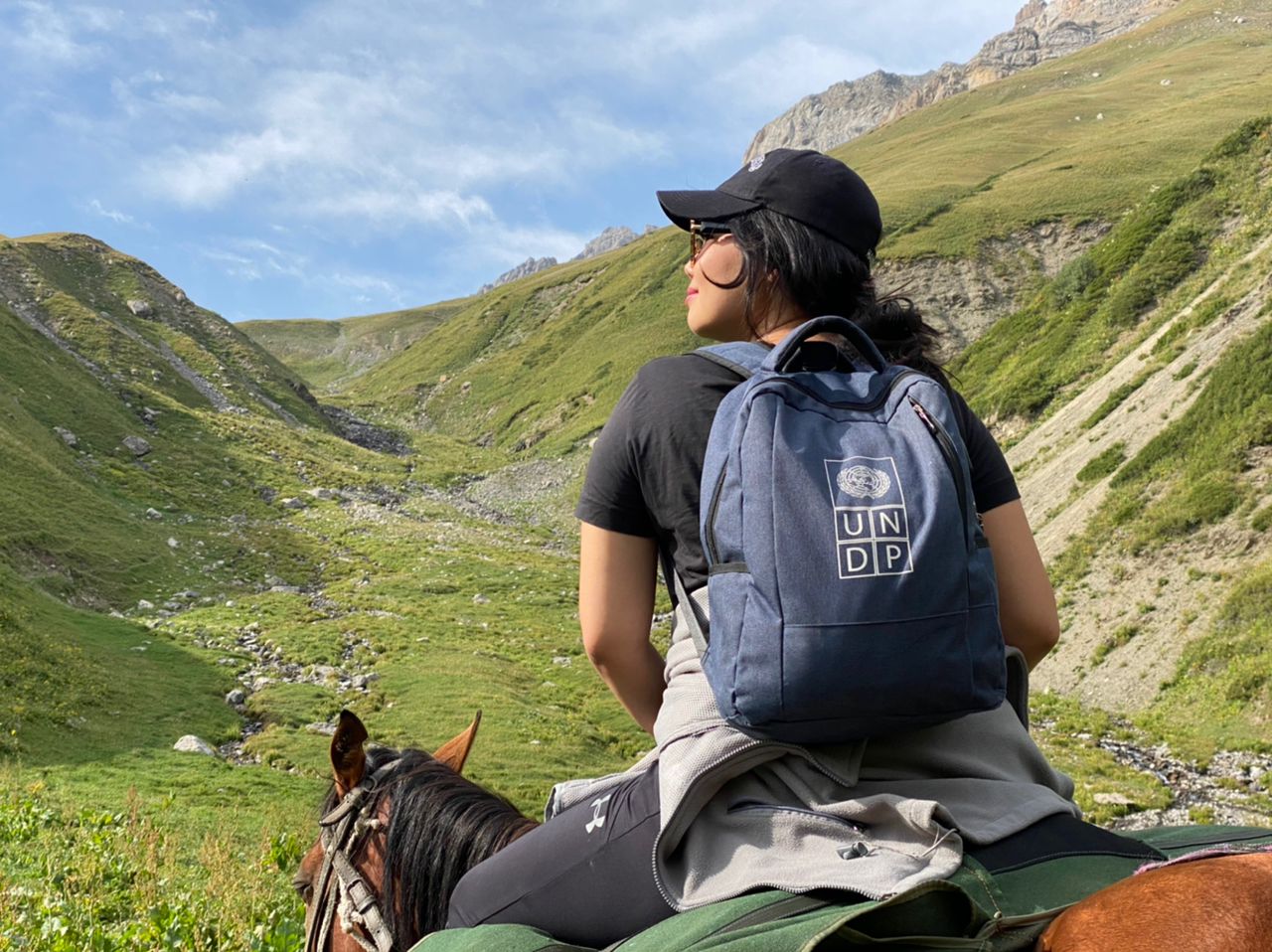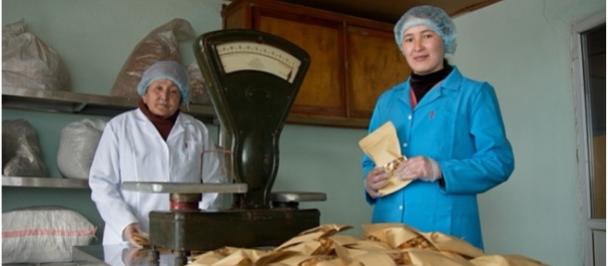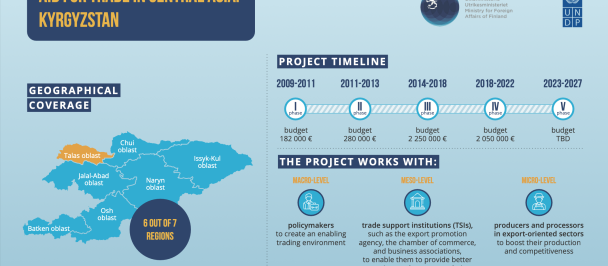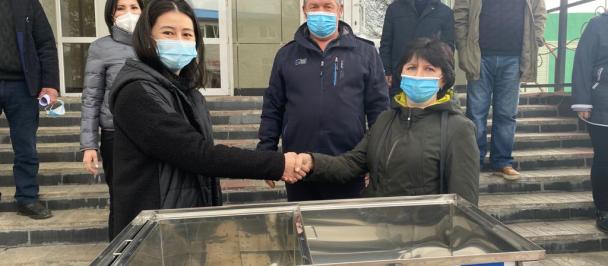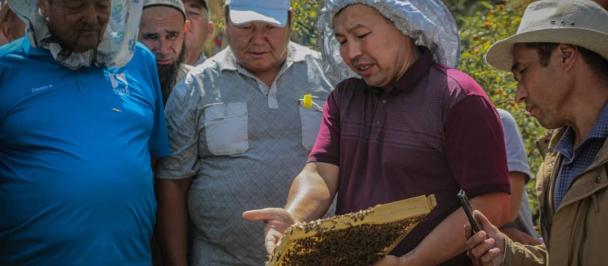UNDP Communications expert - Asipa Altymysheva during the development of a new tourism destination. Photo: Myrzabek Ozubekov
In the age of globalization and the internet, the desire and willingness to discover new countries and cultures, and invest in experiences rather than material goods is gaining momentum around the world. It is not surprising that many countries seriously consider tourism as a tool for sustainable socio-economic development. And Kyrgyzstan, with its fascinating nature and wonderfully hospitable people, is no exception.
For residents of the Kyrgyz regions, tourism can create jobs and stable income. In addition, tourism plays an important role in women's economic empowerment and also contributes to infrastructure development, which in turn positively affects other sectors of the economy.
There are seven provinces in Kyrgyzstan and each has unique characteristics which can be used to develop different types of tourism. Today we will explore one of them - Naryn Province. This region occupies the central part of the country, however, paradoxically, it is the most sparsely populated. It is affected by relatively harsh living conditions and mountainous landscape.
This land of endless grasslands and high mountains with its crystal-clear glaciers and mountain rivers has preserved the characteristics of Kyrgyz nomadic life to present day. This is exactly what makes this region so special.
Today we would like to show you this beautiful region in real time, where tourism development is supported by the Aid for Trade in Central Asia project, funded by the Government of Finland.
We would like to emphasize that the part of Kyrgyzstan we are going to introduce to you has not been studied by tourism companies before. We have conducted a test tour in order to pave a new way in the wilderness.
Map of Kyrgyzstan, blue dot marks the location of the expedition.
Moments before departure. Photo: Asipa Altymysheva / UNDP Kyrgyzstan
After nearly six hours on the road, our tiredness was offset by the stunning views from the car window.
Too-Ashuu pass, Tien-Shan mountains, Kyrgyzstan Photo: Asipa Altymysheva / UNDP Kyrgyzstan
Our route took us through the majestic Too-Ashuu Pass, 3,400 meters above sea level. The serpentine mountain paths are truly breathtaking and the traveler's eyes are filled with indescribable mountain scenery.
Kokomeren mountain river, Zhumgal Valley, Kyrgyzstan. Photo: Asipa Altymysheva / UNDP Kyrgyzstan
Descending from the pass into the Suu-Samyr valley, we arrived in the Zhumgal region, where you can enjoy the noise of the Kokomeren mountain river and the mind-blowing views of the mountains.
Ak-Kul lake, Zhumgal valley, Kyrgyzstan. Photo: Asipa Altymysheva / UNDP Kyrgyzstan
Zhumgal has another stunning place - Ak-Kul Lake, where its mirror-like reflection makes the mountain cliffs and dense forests even more amazing. It is like being in a fairy tale - far away from the hustle and bustle of the city.
Horses grazing in the meadow, Naryn valley, Kyrgyzstan. Photo: Myrzabek Ozubekov.
Our route took us from Zhumgal along mountain trails to Kazarman. As the road we walked had never been travelled before, it was not easy. But the result of our trek was not only our enjoyment of nature, but also for the local people
"We wanted to create a comfortable route for tourists, but we needed funds for this, which we did not have. We are very grateful to UNDP for the help, as we have successfully completed our expedition, I will get a tent, karemats, kurja for my guesthouse and I will drive tourists along this route. Now more tourists will come to us – which would be a good opportunity to develop our region.”
Bekten Kadyrov, a resident of Naryn Oblast, a beneficiary of the Aid for Trade Project
At the starting point of our unexplored route, we saw the cottage of a 50-year-old shepherd who lives with his wife and children, far away from civilisation. There's an unimaginable cosiness and peaceful atmosphere in this corner, which today is valued far more than a brand new smartphone in your hand. There is no electricity, no mobile phones and no internet in this region – perfect for digital detox.
House of a sheperd, Zhumgal region, Kyrgyzstan. Photo: Asipa Altymysheva / UNDP Kyrgyzstan
Milkmaid milking a cow, Zhumgal region, Kyrgyzstan. Photo: Asipa Altymysheva / UNDP Kyrgyzstan
One of the interesting things about Kyrgyz regions is how you can find cattle grazing and milking almost everywhere.
Kyrgyzstan tourism team builds a tent. Photo: Asipa Altymysheva / UNDP Kyrgyzstan
The first evening we set up our tent and got ready for bed. The air is incredibly fresh and all that can be heard around is the sound of flowing water, birds chirping, in short, the sounds of nature alone and no signals from the city.
"Tourism in Kyrgyzstan has huge potential. But it needs to be competently and systematically developed, because of all investment programmes, the tourism business can provide investment in all sectors of the economy and, most importantly, help ordinary citizens. After all, for example, for the production of a particular product, people buy equipment (and it often does not exist in our country), so part of the investment goes back because of imports and does not benefit the country. And in tourism, every som stays in the state: the tourist buys food, rents a bed for the night, uses taxi services, etc. Thanks to this chain, the same farmer who sends goods to shops gets an income."
Myrzabek Ozubekov, a tourism expert.
Herd of sheep and cows, Zhumgal region, Kyrgyzstan. Photo: Asipa Altymysheva / UNDP Kyrgyzstan
The Naryn region is ideal for long journeys: trekking, cycling or travelling by car. The large expanses of the region and its small population can provide tourist with a lot of impressions. The region is famous for its large high-mountain lakes, whose altitude does not drop below 3,000 meters, as well as numerous beautiful and challenging passes that connect the valleys of the Naryn Region with each other.
Horse, Zhumgal region, Kyrgyzstan. Photo: Asipa Altymysheva / UNDP Kyrgyzstan
Early morning in the mountains. Photo: Asipa Altymysheva / UNDP Kyrgyzstan
The landscapes changed, and the new views were even better than the previous ones.
Mountain views during hiking. Photo: Asipa Altymysheva / UNDP Kyrgyzstan
Our provisions for the expedition. Photo: Asipa Altymysheva / UNDP Kyrgyzstan.
We took our food in containers so as not to spoil the clean nature with an accidentally flown away plastic bags.
Riding a horse during the trip. Photo: Asipa Altymysheva / UNDP Kyrgyzstan
The tour can be done by trekking or on horseback. And it's not terrible if you don't know how to ride - kind locals will help you to master skills of horse riding in few minutes.
Of course, you don't need to carry all your meals - you can have tasty and nourishing meal with locals as well as cook yourself by means of mobile gas cooker. We used it for cooking and boiling water for coffee and tea.
Cooking meat and potato during the expedition. Photo: Asipa Altymysheva / UNDP Kyrgyzstan
Early morning view in Kyrgyzstan. Photo: Asipa Altymysheva / UNDP Kyrgyzstan
Homemade lantern in the mountains. Photo: Asipa Altymysheva / UNDP Kyrgyzstan
During these expeditions, we have to use our creativity. Like ours, for example, a makeshift lantern from twigs.
Bekten Kadyrov, Asipa Altymysheva and Kyrgyzstan tourism team during the expedition. Photo: Myrzabek Ozubekov
Here is our wonderful team. In such expeditions we get to know more about nature, but also about new people, and very often the tours bring the explorers together and help them become better friends.
The length of our hiking route was 30 km, and the travel time depends on the pace of the group - it can take from 2 to 6 days.
Sunset at Naryn River, Kyrgyzstan. Photo: Asipa Altymysheva / UNDP Kyrgyzstan
Already on the way back to Bishkek, we could see the striking beauty of the mountainous Naryn River, which stretches across the country for 800 km and then flows into Uzbekistan, where it is called the great Syr Darya. The river originates at the joining of the Kashkasu and Maitara rivers.
This initiative is part of the UNDP Aid for Trade project, supported by the Government of Finland.

 Locations
Locations